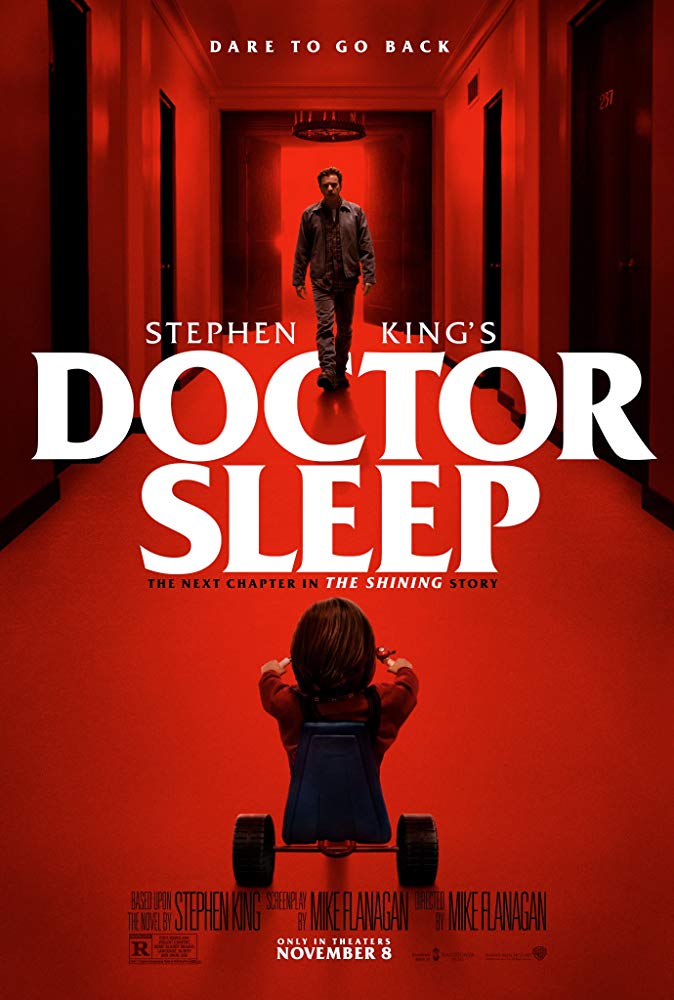Everyone recognizes ‘Red Rum,’ the naked elderly woman in the bathtub in room 237, the tidal wave of blood flooding from elevator doors, and more iconic symbols of Stanley Kubrick’s The Shining. The 1980 film is synonymous with horror classic, with its impact on horror cinema lasting, to quote a certain pair of creepily synchronized twins, forever and ever and ever and ever.
For the majority of its 152-minute runtime, it seems like follow-up Doctor Sleep is able to stand on its own outside of its predecessors’ insurmountable shadow. Director Mike Flanagan handles the camera in a way that pays tribute to Kubrick’s nearly three decade-old directing style, while organically transitioning to the cinematography modern-day machines are capable of filming. But perhaps the opening tracking shot of a young Danny Torrance bicycling through the halls of Overlook Hotel that looked (or perhaps was) directly plucked from The Shining is an early indicator – Sleep can’t go its full runtime without relying on references and nods to the original. That’s a shame, because the movie is good enough to stand on its own.
The story explores on the lore of the ‘Shining’ – psychic abilities few possess – that was mentioned but never expanded upon in the original film. Warner Bros. immediately snapped up the film rights when Stephen King penned the 2013 novel that updates us on the grown-up life of Danny Torrance, more commonly known as the little boy who was chased through the snowy hedge maze by an ax-wielding Jack Nicholson. He’s an adult now (played by Ewan McGregor), but the childhood trauma and his Shining crush him, manifesting in alcoholism inherited from his father. He’s managed to compartmentalize the ghosts that haunted him (including that old lady in the bathtub, of all things) at Overlook Hotel into literal locked suitcases in his mind, trying to seal away that part of his life.
After too many nights spent getting into bar fights and waking up in puddles of vomit, Danny decides to move to a small New Hampshire town to escape his literal and metaphoric demons. Meanwhile, we learn of a cult that feeds on the fear of children with the Shining kidnaps kids in order to maintain semi-immortality. They’re led by Rose the Hat, a top-hatted psychic user played with a simmering intensity by Rebecca Ferguson. The film’s opening scene has Rose luring a child into the woods to eat her, and had Ferguson been wearing clown makeup, it could have been played in either IT movie without anyone noticing. When Rose becomes aware of the powerful Shining energy of a young girl named Abra (Kyliegh Curran), Danny is forced back into the world of the Shining to protect her as a war of literal mind games begins.
Sleep stays close to the original’s slow-burn psychological horrors, with much of the picture playing out in somber quietness. Flanagan exercises the muscles he built directing 2013’s Oculus and 2017’s Gerald’s Game (also a King adaptation) with restraint, though a scene featuring the cult’s kidnapping and torture of an 8-year-old baseball player will leave stomachs in knots.
Before the third act’s inevitable return to Overlook, the movie rarely feels like a sequel. The claustrophobia and increasing sense of danger from being trapped in the hotel can’t be replicated, and that’s fine. The different story calls for a different atmosphere. But what’s regrettably missing here is internal struggle, replaced largely by outward power dynamics between the Shiners and the cult. Jack Nicholson’s portrayal of a slow descent into insanity is the keystone of what makes The Shining so immortal. Replicating a performance like his was never the goal here – but it’s always a missed opportunity when an actor as capable as McGregor is handed a barebones character to work with.
The themes of alcoholism and one generation passing its burdens onto another are dumbed down, all represented by Danny physically struggling with some alcoholic beverage in front of him. Perhaps the best scene of the film is a callback to the bar scene of the original, in which Danny finds himself in a conversation similar to the one his father had with the mysterious bartender Lloyd. But the dependency of the scene on the success of the other undercuts the emotional impact it almost had.
When the Shining battle takes Danny back to the dilapidated hotel in the third act, the lights flicker one by one, revealing a carnival-style lineup of ghosts and ghouls straight from the original. This is where the film becomes the Jurassic World revamp to the original Jurassic Park: It inflates all the action elements of the original while draining out the emotional complexity. It’s a theme park attraction of the original, leaning heavily on nostalgia, and that’s not an inherently bad thing. There is certainly an audience hungry for King content, judging by the box office returns of both IT entries. If that’s what you wanted, this is a great three-hour time sink (factoring in previews). The movie is presented with enough polish to stand on its own. It’s just that it has impossibly big shoes to fill, but still manages to shine in its own less ambitious way.





